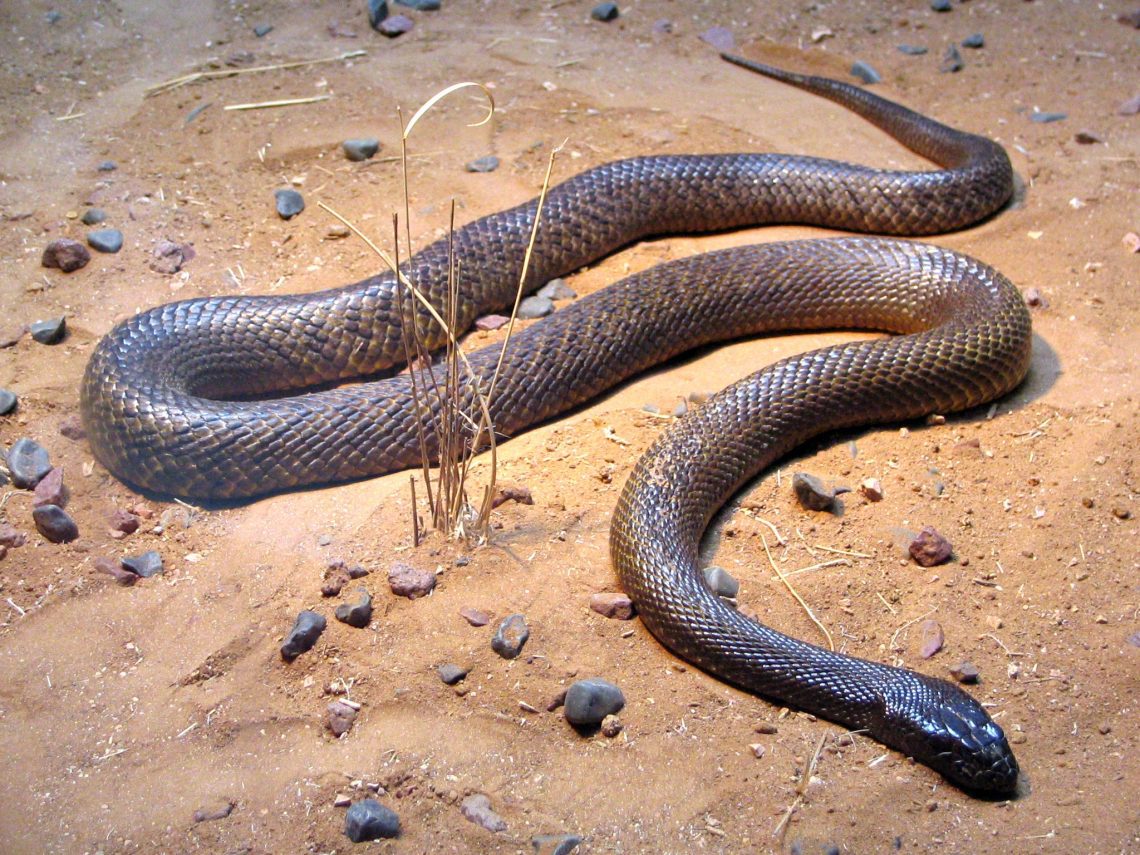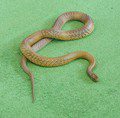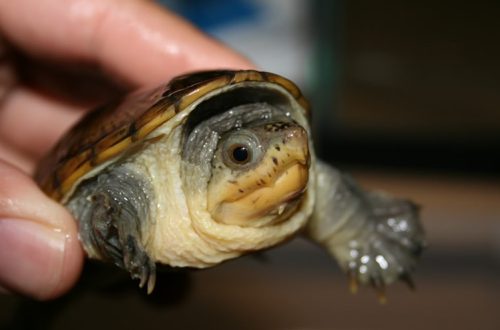
Taipan
Taipans (Oxyuranus) are a genus of venomous snakes of the asp family. Large Australian snakes, whose poison is considered the strongest among modern snakes – before the development of an antitode to it (in 1955), death from a taipan bite reached 90% of cases. There are only 2 types: taipan and a cruel snake. Taipan or coastal taipan (Oxyuranus scutellatus) is the third most venomous snake in the world and the largest (up to 3-3,3 m long) venomous snake in Australia. The taipan is considered the most dangerous of the venomous snakes due to its combination of aggressive disposition, speed, and size. Its poisonous teeth reach 13 mm in length.
Classification
 Kingdom: Animalia (animals)
Kingdom: Animalia (animals)
Subkingdom: Eumetazoa (multicellular, or eumetazoans)
Section: Bilateria (bilateral, or bilaterally symmetrical)
Supertype: Deuterostomia (deuterostome)
Type: Chordata
Subtype: Vertebrata (vertebrates)
Infratype: Gnathostomata (jaws)
Superclass: Tetrapoda (quadrupeds)
Class: Reptilia (reptiles, or reptiles)
Subclass: Diapsida (diapsida)
Infraclass: Lepidosauromorpha
Superorder: Lepidosauria (lepidosaurs)
Order: Squamata (scaly)
Suborder: Serpentes (snakes)
Family: Elapidae (aspididae)
Genus: Oxyuranus (tribe)
Types
 Oxyuranus scutellatus (taipan, coastal taipan, common taipan)
Oxyuranus scutellatus (taipan, coastal taipan, common taipan)
Oxyuranus microlepidotus (violent or ferocious snake)
Oxyuranus temporalis (inland taipan)
Inhabitation
 The coastal taipan is Australia’s largest venomous snake. Moreover, it is one of the deadliest snakes in the world. In addition to Australia, this species is also found in New Guinea.
The coastal taipan is Australia’s largest venomous snake. Moreover, it is one of the deadliest snakes in the world. In addition to Australia, this species is also found in New Guinea.
Taipan inland has also been found in Australia.
The habitat of a cruel snake is limited to Western Queensland, although it can sometimes be found in the north of New South Wales and the Northern Territory.
Description
 The poison of the coastal taipan has both a neurotoxic effect, which causes paralysis, and a coagulative effect, which prevents blood from clotting.
The poison of the coastal taipan has both a neurotoxic effect, which causes paralysis, and a coagulative effect, which prevents blood from clotting.
Poisonous teeth, about 1 cm long, strike the victim when bitten by a solid dose of poison. Before the development of an antidote for taipan poison (in 1955), more than 90% of cases died from its bite. The most aggressive taipan behaves during mating and skin change. The length of an adult individual can reach 3 meters or more.
The New Guinean subspecies, unlike the Australian subspecies, has a darker color.
A fierce snake can reach a length of 1 m. The color of the back varies from dark brown to straw, changing depending on the seasons – noticeably darker in winter. The head may take on a glossy black color.
The cruel snake is the most venomous of the land snakes. On average, 44 mg can be obtained from one individual. poison. This amount will be enough to kill 100 people or 250 mice. But at the same time, unlike the taipan, this snake is not aggressive, all cases of bites were the result of careless handling.
Food
The main diet of the snake is made up of frogs and small mammals, including rats and mice.
Reproduction
 Mating mainly takes place in the male’s shelter, and snakes can mate in almost any month of the year. Also, one female can make two or three clutches during the year.
Mating mainly takes place in the male’s shelter, and snakes can mate in almost any month of the year. Also, one female can make two or three clutches during the year.
The number of eggs laid ranges from 5 to 22 eggs. The average egg size is 65×30 mm. The incubation period lasts about 56-66 days.
Content
Taking into account the extreme aggressiveness of taipans and the high toxicity of their poisons, in the 80s of the 20th century, these snakes belonged to the category of snakes that should not be kept in captivity at all. In subsequent years, attempts were made by some zoos to keep taipans in captivity, but even today the number of these snakes in zoo collections is extremely small.
Additionally
 Taipan inland was opened in 2007 and so far only a single copy has been registered. Nevertheless, scientists do not give up hope of finding his “relatives” in other remote places on the planet.
Taipan inland was opened in 2007 and so far only a single copy has been registered. Nevertheless, scientists do not give up hope of finding his “relatives” in other remote places on the planet.
In Australia, you can also find a snake of the snake family, which is very similar to the taipan (Tropidonophis mairii or keelback). However, it is not poisonous.
The venom of a fierce snake is about 50 times stronger than that of a cobra.
After a taipan bite, the vaccine must be administered within only 3 minutes, otherwise there will be no chance of survival.
Sources of
http://ru.wikipedia.org
http://www.alins.ru
http://petland.org.ua
http://crazy-zoologist.livejournal.com
http://www.myreptile.ru
http://www.yadoktor.ru





